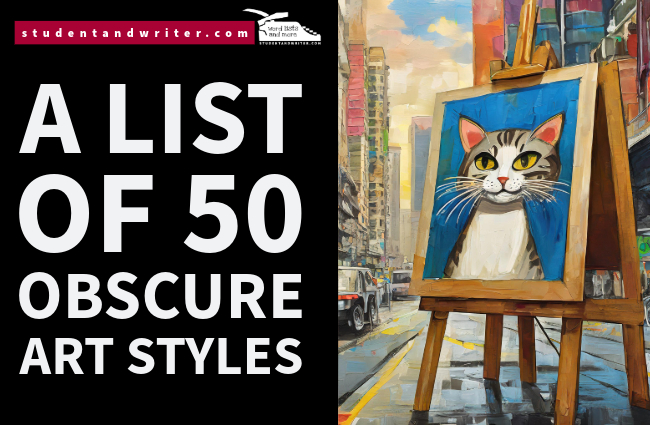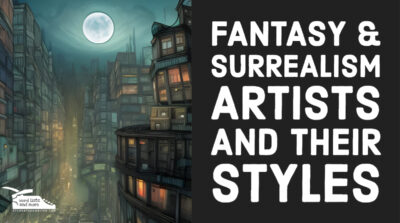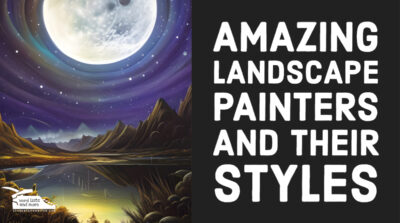Exploring Obscure Art Styles: A Journey Beyond the Conventional
Welcome to an intriguing journey through some of the world’s most obscure art styles! From the minimalist expressions of Arte Povera in Italy to the dynamic energy of the Vorticism movement in Britain, this post delves into various art forms that stand out for their unique approaches and philosophies. We’ll explore how movements like Rayonism and Kinetic Art broke traditional boundaries and introduced new perspectives to the art world. Whether you’re an art enthusiast or a curious novice, this exploration will expand your understanding of how diverse and innovative art can be. Let’s embark on this artistic adventure together and discover the less trodden paths of the art world!
Here’s a list of 50 obscure or less commonly known art styles, each with a brief description:
- Arte Povera – Italian movement focusing on simple materials and objects in art to challenge commercialization. (examples of Arte Povera on Google images)
- Vorticism – Early 20th-century British movement characterized by bold, abstract, and dynamic compositions. (examples on google images)
- Tachisme – European counterpart to abstract expressionism, characterized by spontaneous brushwork, drips, and scribble-like marks. (google image search examples)
- Rayonism – Russian avant-garde style using dynamic rays of light to represent forms in abstraction. (google image search examples)
- Synchromism – American movement that sought to portray sound in color through the use of rhythmic forms. (google image search examples)
- Luminism – An American landscape painting style of the 19th century that emphasized quiet and clarity. (google image search examples)
- Cloisonnism – Style developed by post-Impressionist painters using bold and flat forms separated by dark contours. (google image search examples)
- Fauvism – Early 20th-century French art style marked by bold, shocking color. (example)
- Constructivism – Early 20th-century emphasis on abstract art constructed from industrial materials. (google image search examples)
- Suprematism – Russian movement focused on basic geometric forms and pure artistic feeling. (google image search examples)
- Situationism – Avant-garde movement focused on critical theories of society and the construction of situations. (google image search examples)
- Ephemeral Art – Works made to last for a temporary period before degrading or being destroyed. (google image search examples)
- Psychogeography – Exploration of urban environments that emphasizes playfulness and “drifting.” (google image search examples)
- Neo-Concretism – Brazilian movement that proposed an art that was expressive and subjective, involving the viewer. (google image search examples)
- Color Field Painting – Style of abstract painting that emerged in New York in the 1940s and 1950s, focusing on large fields of flat, solid color. (google image search examples)
- Assemblage Art – Art made by compiling and mounting found or unrelated objects. (examples on google)
- Hypermodernism – Art that reflects the complexities of the modern digital age, focusing on themes like globalization, technology, and identity in a hyper-connected world. (google image search examples)
- Op Art – Short for “Optical Art,” this style creates optical illusions. (examples on google images)
- Biomorphism – Art movement with style derived from organic or natural forms.
- Spatialism – Aimed at the creation of art evolved to encompass four dimensions, including both time and space. (examples on google)
- Mail Art – Artistic movement centered on sending small scale works through the postal service. (examples on google)
- Fluxus – An international network of artists, composers, and designers noted for blending different artistic media and disciplines in the 1960s. (examples on google)
- Orphism – Offshoot of Cubism focused on pure abstraction and bright colors. (google image examples)
- Hard-edge Painting – Painting style characterized by large areas of solid color with sharp, clean edges. (google image examples)
- Lettrism – Movement that is notably typographic in its emphasis, seeking meaning in letters and symbols. (google image examples of Lettrism)
- Neoism – Movement of the 1980s that involved performance art, mail art, and collaborative creation. (examples on google images)
- Hurufiyya Art – Art movement in the Middle Eastern countries which integrates Islamic calligraphy and modern art. (examples on google images)
- Sots Art – Soviet version of Western pop art, combining elements from Socialist Realism and commercial advertising. (pretty strange sots art examples on google images)
- Zaum – A form of Russian Futurism characterized by transrational language and a focus on sound. (google image link to zaum art samples)
- Stuckism – International art movement founded in 1999 that advocates figurative painting in opposition to conceptual art. (google stuckism images)
- Toyism – Distinctive and playful style of painting that emerged in the 1990s in the Netherlands. (google link to images of toyism)
- Artefactoria – A modern style that combines digital media with traditional painting techniques. (google link – examples)
- Lowbrow Art – A populist art movement with its cultural roots in underground comic, punk music, and hot-rod cultures of the street. (google link to lowbrow art)
- Photorealism – Painters draw influence from photography to reproduce the image as realistically as possible in another medium. (google link to photorealism images)
- Outsider Art – Art by self-taught or naïve art makers. (examples on Google images)
- Brutalism – Architecture movement characterized by simple, block-like structures and raw concrete construction. (examples on Google images)
- Haptic Art – Art that adds a tangible or touchable dimension to the experience of art. (examples on Google images)
- Eco Art – Art that is created with sustainability in mind, often using recycled materials or engaging with themes of environmentalism. (examples on Google images)
- Spectralism – Originally a style of contemporary classical music that focuses on the acoustic spectrum, applied to visual arts it deals with visualizing frequencies and sound. (examples on Google images)
- Art Informel – 1945 abstract art that is gestural and intense. (examples on Google images)
- Neue Sachlichkeit – German “New Objectivity” art movement that emerged in the 1920s as a reaction against expressionism. (examples on Google images)
- Dada – European avant-garde movement of the early 20th century that ridiculed contemporary culture and traditional art forms. (examples on Google images)
- Vexel Art – Digital art that mimics the visual appearance of vector graphics, using raster layering techniques. (examples on Google images)
- Light and Space – A Californian art movement focusing on perceptual phenomena, such as light, volume, and scale. (examples on Google images)
- Algorithmic Art – Art created with the use of algorithms, often with the input of minimal human intervention beyond creating the algorithm itself. (examples on Google images)
- Intervention Art – Art that intervenes in everyday settings, aiming to disrupt the commonplace and challenge societal norms. (examples on Google images)
- Environmental Art – Art that helps improve our relationship with the natural world, often site-specific and designed to transform the perception of space. (examples on Google images)
- New Leipzig School – A recent German art movement characterized by revisiting the traditional genres of painting with a fresh contemporary eye. (examples on Google images)
- Tape Art – A form of street art that involves the use of adhesive tape to create durable images or sculptures on walls or various surfaces. (examples on Google images)
- Gutai Art Movement – A post-war Japanese movement that emphasized the physical involvement of the artist with materials, focusing on spontaneity and dynamism. (examples on Google images)
- Monochrome Painting – Art where one single color or hue is used to create a painting to emphasize texture, subtlety, and composition. (examples on Google images)
- Nuclear Mysticism – Combines elements of science, spirituality, and philosophy, often inspired by the atomic age and its implications. (examples on Google images)
- Quantum Art – Art inspired by the principles of quantum physics, exploring concepts of entanglement and superposition through visual representation. (examples on Google images)
- Pataphysics – A pseudo-scientific and absurdist art movement based on the “science of imaginary solutions” and the principles set out by Alfred Jarry. (examples on Google images)
- Transautomatism – A style developed by Friedensreich Hundertwasser that focuses on subconscious painting techniques and organic forms. (examples on Google images)
- Panic Movement – An avant-garde performance art group founded by Fernando Arrabal, Alejandro Jodorowsky, and Roland Topor, focused on chaotic and surreal performance pieces. (examples on Google images)
- Metaphysical Painting (Pittura Metafisica) – An Italian movement founded by Giorgio de Chirico, characterized by eerie, dream-like scenes with sharp contrasts of light and shadow. (examples on Google images)
- Elementalism – Focuses on the essential components of natural phenomena and the primal, elemental forces of nature. (examples on Google images)
- Arte Útil – Translates to “useful art,” it focuses on art as a tool for social change and involves the community in the creation process. (examples on Google images)
These styles represent a wide range of creative expressions and highlight how diverse the art world can be.
How Can You Experience These Art Styles?
If you’re inspired to learn more about these fascinating art movements, there are several ways to immerse yourself. Start by visiting local museums or galleries that feature contemporary or abstract art, as they often include lesser-known movements. Many online virtual tours now offer access to collections worldwide, allowing you to explore art from different cultures and eras right from your home. Art books and documentaries can also provide deeper insights into these styles. Additionally, participating in art workshops or classes focused on abstract and experimental art can give you a hands-on experience. Embrace the diversity of the art world by exploring these unique styles that break the mold of traditional art.



